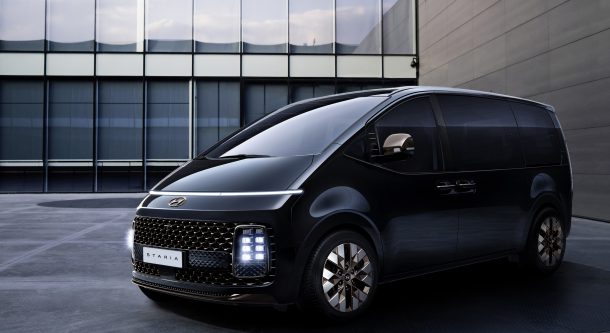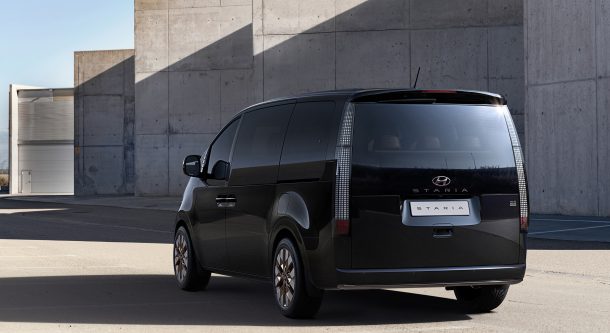2022 Hyundai Staria People Mover Unveiled
Inching closer to its mid-year debut, the 2022 Hyundai Staria multi-purpose vehicle (MPV) was revealed yesterday, with the premise of next-level mobility.
Minivan though it may be, at no point did Hyundai use this often-maligned vehicle classification. In the world of auto sales, it is the people mover that a family of four or more can hardly live without and that many parents dread for the stigma associated with them.
If you’ll recall, the MPV was Mazda’s minivan entry for more than 20 years, a hauler with some of the same ‘zoom-zoom’ zest found in other Mazdas. While the Staria isn’t absconding with the nameplate, they are happy to use it as a descriptor for something that’s clearly a minivan.
Hyundai has introduced a new term, purpose-built vehicles (PBVs) to somehow move the discussion away from minivans, and to these ‘new’ PBVs, if not in practice, well, at least as a point of reference.
What we know from Hyundai’s release yesterday is that there’s going to be a 2-seat Staria, which would make sense as a work vehicle, and in 7-, 9-, and 11-seat passenger configurations. There will be Premium versions, although the 11-seat Staria Premium is available only in Korea. The nine-seat Premium will have second-row seats with the ability to swivel 180-degrees, so that rousing conversations among occupants can take place while the vehicle is in motion.
When Hyundai compares the Staria to a cruise ship, you start thinking that maybe it’s going to be a boat. Without any dimensions, it’s hard to gauge whether the Staria is going to emulate the turning radius of a short school bus, or it will be a bit more nimble. There is a lot of glass, which compares nicely with that of a tour bus. Judging by the side view, think hunkered-down, low-to-the-ground Chevy Express/GMC Savana.
Futuristic though the front fascia may be due to its horizontal daytime running lights, and a lighted ‘halo’ Hyundai compares to the Earth’s horizon at sunrise if you were to view it from space, it’s very much like K.I.T.T. from the ‘Nightrider’ TV series, no? Its snub nose is somewhat reminiscent of the Toyota Previa minivan of twenty-odd years ago too, albeit with what we think will be a much longer body than that of the Toyota. But then again, it wasn’t in this era of personal space and social distancing that the Toyota was designed.
While there were no images of the dash and its 10.25-inch display screen, relaxation-mode premium seating in their 7-seat high-end variant, or the 64-color ambient mood lighting that’s available on all Staria Premium models, you now have some idea why Hyundai isn’t content to call it a minivan and leave it at that.
[Images: Hyundai, Toyota]
With a father who owned a dealership, I literally grew up in the business. After college, I worked for GM, Nissan and Mazda, writing articles for automotive enthusiast magazines as a side gig. I discovered you could make a living selling ad space at Four Wheeler magazine, before I moved on to selling TV for the National Hot Rod Association. After that, I started Roadhouse, a marketing, advertising and PR firm dedicated to the automotive, outdoor/apparel, and entertainment industries. Through the years, I continued writing, shooting, and editing. It keep things interesting.
More by Jason R. Sakurai
Latest Car Reviews
Read moreLatest Product Reviews
Read moreRecent Comments
- SCE to AUX Everything in me says 'no', but the price is tempting, and it's only 2 hours from me.I guess 123k miles in 18 years does qualify as 'low miles'.
- Dwford Will we ever actually have autonomous vehicles? Right now we have limited consumer grade systems that require constant human attention, or we have commercial grade systems that still rely on remote operators and teams of chase vehicles. Aside from Tesla's FSD, all these systems work only in certain cities or highway routes. A common problem still remains: the system's ability to see and react correctly to obstacles. Until that is solved, count me out. Yes, I could also react incorrectly, but at least the is me taking my fate into my own hands, instead of me screaming in terror as the autonomous vehicles rams me into a parked semi
- Sayahh I do not know how my car will respond to the trolley problem, but I will be held liable whatever it chooses to do or not do. When technology has reached Star Trek's Data's level of intelligence, I will trust it, so long as it has a moral/ethic/empathy chip/subroutine; I would not trust his brother Lore driving/controlling my car. Until then, I will drive it myself until I no longer can, at which time I will call a friend, a cab or a ride-share service.
- Daniel J Cx-5 lol. It's why we have one. I love hybrids but the engine in the RAV4 is just loud and obnoxious when it fires up.
- Oberkanone CX-5 diesel.









































Comments
Join the conversation
Come to think of it 4 wheel steering would be helpful on this thing as well.
Reminds me of the GM "dustbuster" minivans.